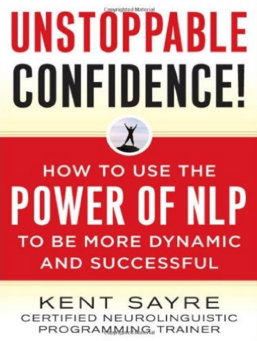I recently read “Unstoppable Confidence: How To Use The Power of NLP To Be More Dynamic and Successful” by Kent Sayre. Below are the quotes I found most interesting. If you like the quotes, buy the book here.
 “Truly confident people all had a similar trait: their confidence came from within and it did not have to be voiced. A nonchalant, matter-of-fact confidence is ideal.” (24)
“Truly confident people all had a similar trait: their confidence came from within and it did not have to be voiced. A nonchalant, matter-of-fact confidence is ideal.” (24)
“Competence is defined as the ability to do something, and confidence is defined as your belief about your competence.” (27)
“There are four levels of competence that people go through as they develop any skill. Those four levels are: unconscious incompetence, conscious incompetence, conscious competence, and unconscious competence.” (28)
“Confident people make decisions rapidly and with a sense of finality. Once a decision is made, they are committed to it. They rarely change their minds. Confident people never waver because they know what they want.” (35)
“When you ask yourself, “how can I be of service to others today?” you will experience a paradigm shift of great proportions.” (39)
“A goal is a dream with a deadline.” (43)
“I encourage you to focus mostly on having a positive motivation strategy, allowing you to seek better things in your life. The most successful people have the positive motivation.” (51)
“Calling something “confidence” is actually a misnomer. There is only such a thing as acting confident or behaving in a confident way or thinking confident thoughts. The same goes for any emotion, be it fear, sadness, depression, or anxiety. None of these are actual “things.” They are the result of processes, sequences of thought that you run in your mind.” (59)
“Instead of saying “I feel sad,” describe for yourself what is really going on: “I choose to think in a certain way that results in my feeling sad when I encounter a certain set of circumstances.”” (61)
“Append “according to me at this time” onto every one of her sentences. This forces her to acknowledge that what she is describing is not absolute truth and not etched in stone for all time.” (63)
“Whenever there is an unwanted emotion (like fear, guilt, or anxiety), she must describe the emotion with the following phrase: “I choose to experience a certain emotion by doing something inside my mind that causes me to experience a set of pictures, sounds, and feelings that I collectively have labeled [emotion].” (63)
“After she restates it using the guidelines above, she must empower herself by using sentences that state how she will behave in the future. An example is: “Although I’ve done that in the past, I wonder how quickly I will find myself becoming more relaxed and confident when I go to ask the customers to purchase my product.” (63)
“When you change your language, you change your life.” (64)
“Ask yourself whether a particular belief serves you. If so, keep it. If the belief keeps you stuck in a station of your life that you’ve outgrown, get rid of it and replace it with a more empowering belief.” (67)
“If you have something positive that you want to experience more vividly, you can enlarge whatever you are visualizing – make it movie screen-size in your mind-and notice how that feeling becomes more intense. You can make that belief even more intense by making it brighter in your mind and picturing it being closer.” (69)
“The reverse is also true: If you want to make something less powerful, you can visualize it as being small, dark, and far away. To lessen the intensity even further, you can make the picture of what you’re thinking about grainy and black and white, as though you were viewing it on an ancient television screen.” (70)
“When you meet people and you want to create rapport, remember these beliefs:
People automatically like you because you are a good person
You can easily and naturally meet anyone you choose
You can have instant rapport with anyone you choose using these techniques
You have a lot in common with any person you meet
You can learn something from each and every person you speak with” (77)
“In all interpersonal relations, assume that you can get and maintain a rapport. Operate under the belief that you have far more in common with the person than not, and you will easily connect with him or her.” (77)
“Ask yourself, “What would it be like if I were feeling unstoppably confident right now?” How would you feel different? How would you look out at the world as a supremely confident person?” (78)
“All friendships are based on: similarity, cooperation, praise.” (80)
“If you intend to connect with someone before beginning to talk with him or her, you will project that intent and that person will unconsciously pick up on it, responding to you more positively than he or she might have otherwise.” (82)
“When you set someone else’s comfort as one of your outcomes, that person will find himself or herself automatically more comfortable in your presence.” (82)
“Adopt the belief that people are perfectly friendly and they love meeting new, dynamic people such as yourself. Furthermore, recognize that you like to get to know new people, since you can learn something new from each and every person you meet. You accept people for who they are, allow them to be themselves, and are free from judging them. After permanently adopting this frame of mind, go out each day or night for the week and notice how easily and naturally you converse with strangers.” (82)
“When someone is genuinely comfortable in being himself or herself, others esense it and consequently let their guard down.” (83)
“All the happiest, most fulfilled, most successful people realize that success is a process. It’s the journey of who we become, not simply the end result, that makes it all worthwhile. The achievement of the goal is sweet. But, as with any goal worth achieving, there will likely be setbacks along the way. Viewing those setbacks in the right light can make the difference in your ultimate success.” (91)
“There is no such thing as failure; there are only results. After you’ve been knocked down, the only thing that matters is that you get back up.” (92)
“Masters become masters because they make more mistakes. The more mistakes you make, the more distinctions (small pieces of information you learn by doing) you’ll get. The more distinctions you have, the more easily you will reach your outcome.” (92)
“If at first you’re not successful, be thankful. Some of the least successful people out there had early successes and decided that there was no room for improvement; therefore they became complacent and stagnated.” (92)
“Compare this to people who fail royally the first few times. These late bloomers have to develop skills to adjust their behavior based on feedback. They tend to develop habits that lead them toward continual improvement. As they develop these habits and being to succeed, they eventually surpass the early bloomers in productivity.” (93)
“To get your victories to occur more often, just as soon as you have a major success, visualize yourself having the same results again in many different contexts.” (98)
“What makes the difference between successful, confident people and those who are tentative and do not pursue their dreams is the way that they view their mistakes. If you want to do something well, it’s worth doing poorly at first. That is why taking action is almost always better than not taking action. In taking action, you will either get your outcome or at least learn something, so that you can do things better the next time. If you fail to take action out of fear, you will learning nothing and stay stuck in the same place you were.” (99)
“Imagine what it would be like to be ten times more confident than you are now, and answer the following questions:
How would you be moving differently?
How would your body posture be different?
How would your inner voice be different?
How would you be speaking to others?
What is going through your mind?
How does your body feel?
Where in your body do you feel that confidence first?
How could you intensify that confident feeling in your body?” (105)
“Make a game of finding something positive in every situation. Ninety-five percent of your emotions are determined by how you interpret events to yourself.” -Brian Tracy (109)
“When you’re aware of the specific qualities of your negative internal voice, you can more easily silence it.
Whose voice do you hear?
Where does the voice seem to come from?
At what level is the volume of the voice?
Does the voice speak rapidly or slowly?” (111)
“Sometimes the negative internal voice is your own. What would happen if you took the voice and made it sound like, say, Mickey Mouse’s voice? It would be hard to take that high-pitched voice seriously, right?” (111)
“The more you reward yourself for acting in the way you want, the more you will find yourself automatically acting in the way you want. You won’t even have to make it a point to do so – it will simply become a reflex.” (112)
“Your ideal internal dialogue should be in your own voice. The reason for this is that you and you alone run your life and make the decisions.” (113)
“Words that are confidence killers: try, hope, but, would, could, should.” (116)
“The word try communicates a “maybe” attitude in a world that craves certainty. Instead, use the word do.” (117)
“If you want to communicate the same thing without using the word but, substitute the phrase and yet.” (118)
“Here are the words and phrases to add to your vocabulary for enhanced confidence: absolutely, definitely, positively, assuredly, without a doubt, of course, certainly, undoubtedly, obviously, guaranteed, naturally, sure.” (120)
“A classic placating gesture is when someone shrugs her shoulders with palms facing upward, as if pleading, “I didn’t do it.” This conveys a need to absolve oneself of responsibility for a situation. In order to have unstoppable confidence, you must avoid these gestures at all times. Another placating gesture is the shrug, which means that someone doesn’t really know what’s happening – or perhaps doesn’t even care.” (129)
“Keep your head held high, your shoulders back, your tummy tucked in, and move through the world with deliberate steps.” (131)
“Get in the habit of steepling your hands when you want to convey confidence to others.” (131)
“If you want more confidence, all you have to do is smile.” (131)
“Vividly imaging confidence in your future means you are literally programming yourself to have that confidence when you need it.” (143)
“Here is how to set yourself up to have confidence any time:
Close your eyes
Watch yourself on your mental movie screen being confident
Enhance the visual and sound qualities of the movie
Jump into your on-screen body and sse through your own eyes, hear what you hear, and feel that total confidence
Hold your thumb and first finger together as you experience fondience
The more you feel confident, the harder you press your thumb and first finger together
After five seconds, separate your thumb and first finger and open your eyes
Repeat the first seven steps, but watch a different confident scenario” (144)
“I imagined that I had an entire history of making wonderful speeches, motivating audiences, and receiving standing ovations for my abilities. To go one step further, I imagined people taking my message to heart, acting on it, and transforming their lives.” (161)
Liked the quotes? Click here to buy the book.

